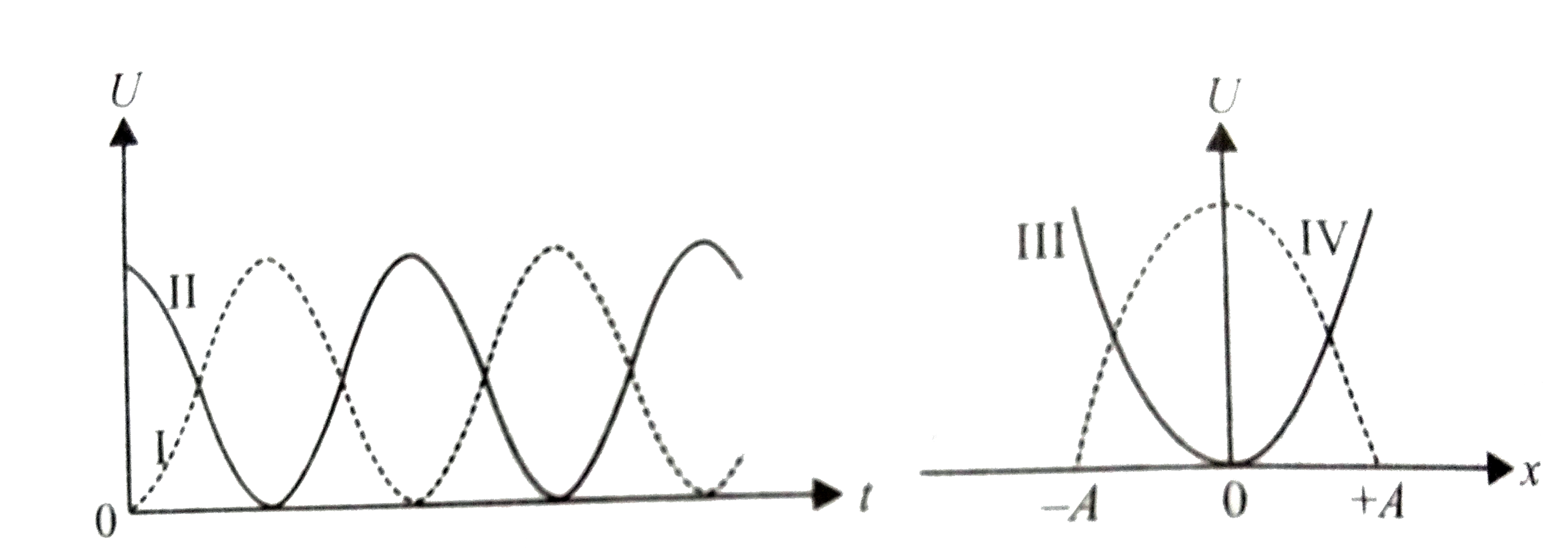A body executes simple harmonic motion. At a displacement x, its potential energy is U1. At a displacement y, its potential energy is U2. What is the potential energy of the body at a displacement (x + y)?
U1+U2
(√U1+√U2)2
√U21+U22
√U1U2
The correct Answer is:B
To find the potential energy of a body executing simple harmonic motion (SHM) at a displacement of x+y, we can follow these steps:
1. Understand the formula for potential energy in SHM:
The potential energy U of a body in simple harmonic motion at a displacement x is given by the formula:
U=12kx2
where k is the spring constant.
2. Write the expressions for potential energy at displacements x and y:
- At displacement x:
U1=12kx2
- At displacement y:
U2=12ky2
3. Find the potential energy at displacement x+y:
The potential energy at displacement x+y can be expressed as:
U=12k(x+y)2
4. Expand the expression:
Expanding (x+y)2:
(x+y)2=x2+2xy+y2
Therefore, the potential energy becomes:
U=12k(x2+2xy+y2)
5. Substitute x2 and y2 using U1 and U2:
From the expressions for U1 and U2:
x2=2U1kandy2=2U2k
Substituting these into the potential energy expression:
U=12k(2U1k+2xy+2U2k)
6. Simplify the expression:
The terms involving k will cancel out:
U=U1+U2+kxy
7. Express xy in terms of U1 and U2:
To express xy, we can use the square root of the potential energies:
xy=√(2U1k)(2U2k)=2√U1U2k
8. Final expression for potential energy:
Substitute xy back into the potential energy equation:
U=U1+U2+2√U1U2k
9. Rearranging the expression:
This can be rewritten as:
U=U1+U2+2√U1U2
Conclusion:
The potential energy of the body at a displacement x+y is given by:
U=U1+U2+2√U1U2
The potential energy U of a body in simple harmonic motion at a displacement x is given by the formula:
U=12kx2
where k is the spring constant.
- At displacement x:
U1=12kx2
- At displacement y:
U2=12ky2
The potential energy at displacement x+y can be expressed as:
U=12k(x+y)2
Expanding (x+y)2:
(x+y)2=x2+2xy+y2
Therefore, the potential energy becomes:
U=12k(x2+2xy+y2)
From the expressions for U1 and U2:
x2=2U1kandy2=2U2k
Substituting these into the potential energy expression:
U=12k(2U1k+2xy+2U2k)
The terms involving k will cancel out:
U=U1+U2+kxy
To express xy, we can use the square root of the potential energies:
xy=√(2U1k)(2U2k)=2√U1U2k
Substitute xy back into the potential energy equation:
U=U1+U2+2√U1U2k
This can be rewritten as:
U=U1+U2+2√U1U2
The potential energy of the body at a displacement x+y is given by:
U=U1+U2+2√U1U2
Topper's Solved these Questions
Similar Questions
A body is executing simple harmonic motion. At a displacement x, its potential energy is E1 and a displacement y, its potential energy is E2. The potential energy E at a displacement (x+y) is
View SolutionA body is executing simple harmonic motion. At a displacement x (from its mean position) its potential energy is E1 and at a displacement y its potential energy is E2. The potential energy is E at displacement (x+y) . Then:
View Solution
Knowledge Check
A particle is executing simple harmonic motion. Its total energy is proportional to its
Adisplacement from equilibrium positionBfrequency of oscillationCsquare of amplitude of motionDvelocity at equilibrium positionA particle executing SHM with an amplitude A. The displacement of the particle when its potential energy is half of its total energy is
AA√2BA2CA4DA3
A body is performing SHM At a displacement X1, its potential energy is 4 J and at a displacement X2, its potential energy is 9 J. The potential energy at a displacement (X1+X2) is
View SolutionFor a particle executing simple harmonic motion, the displacement x is given by x=Acosωt. Identify the graph, which represents the variation of potential energy (U) as a function of time t and displacement x.

View SolutionAt what displacement the kinetic is equal to the potential energy ?
View SolutionIn a simple harmonic motion, when the displacement is one-half the amplitude, what fraction of the total energy is kinetic ?
View SolutionIn SHM with amplitude a, the potential energy and kinetic energy are equal to each other as displacement
View SolutionIn simple harmonic motion of a particle, maximum kinetic energy is 40 J and maximum potential energy is 60 J. then
View Solution
